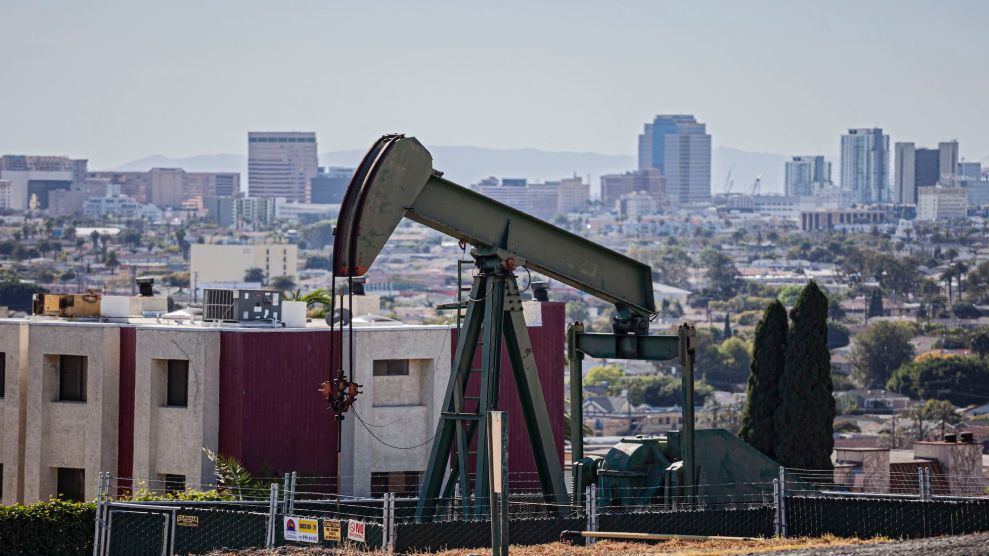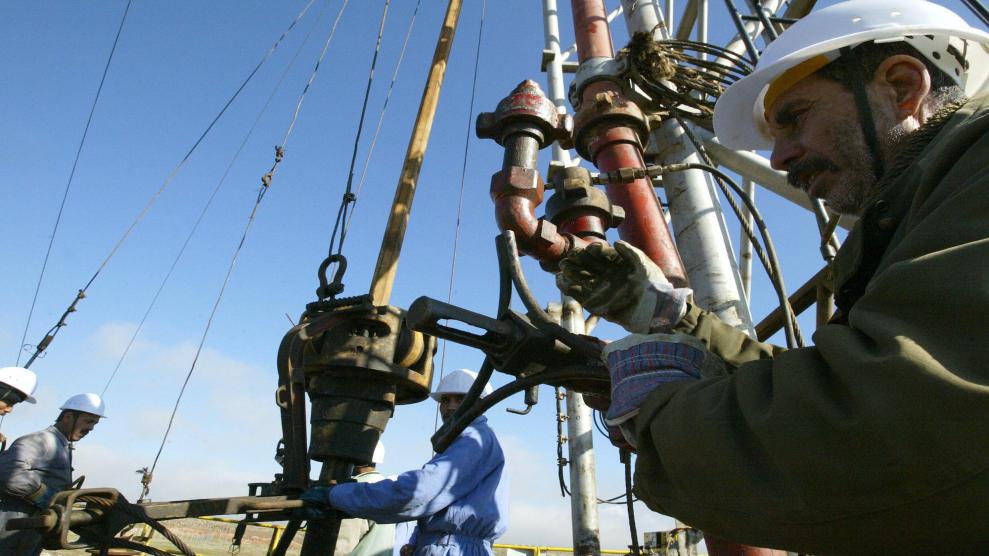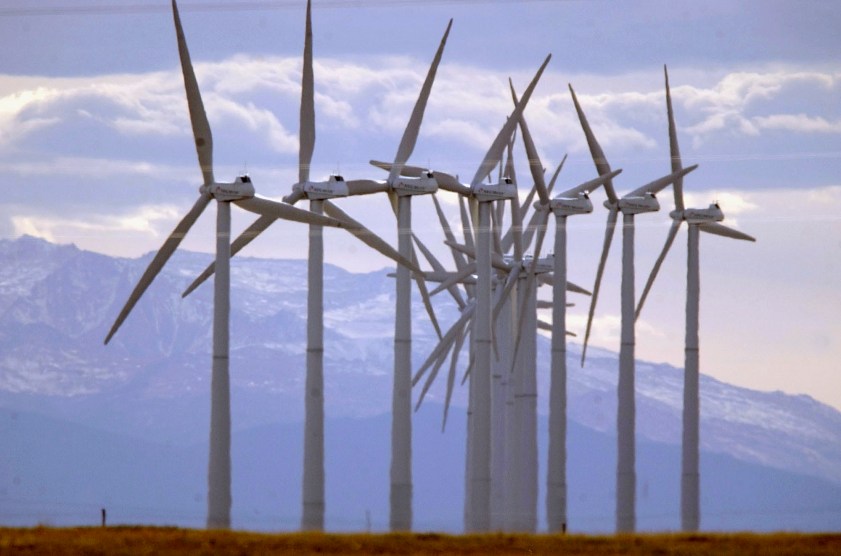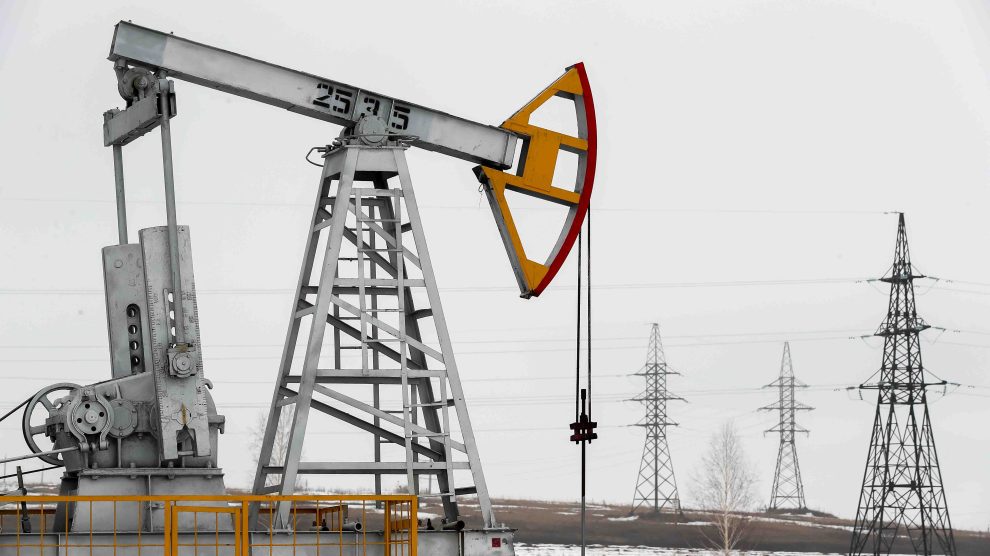
A well and pump jack in Los Angeles County.(Citizen of the Planet/Education Images/Universal Images Group/Getty)
This story was originally published by Yale E360 and is reproduced here as part of the Climate Desk collaboration.
Nalleli Cobo was nine years old when her nose started bleeding, off and on throughout the day, and often into her pillow at night. Then came the headaches and heart palpitations; for a while, her doctor had her wear a heart monitor. “I got to the point where I couldn’t walk,” Cobo, who is now 20, says. “My mom had to carry me from place to place.”
Doctors were stumped as to what was wrong. “I’d always been a healthy little girl,” Cobo recalled. “And then all of a sudden I’m meeting cardiologists and neurologists and all these other -ologists, and no one could figure out what I had.” Only after being sick for four years, in 2013, did she get a possible answer. Physicians for Social Responsibility, a public-health nonprofit, sent a toxicologist to Cobo’s South Los Angeles community to talk about how certain chemical byproducts of oil extraction, among them benzene and hydrogen sulfide, can cause symptoms similar to what Cobo was experiencing.
“That’s when we made the connection,” Cobo says. As it turned out, her symptoms had coincided with a 400 percent ramp-up in production at a drilling site just 300 feet from where she lived.
Every year, upward of 140 million barrels of oil are extracted from the state of California, flowing from the vast Monterey Formation that spans nearly the entire state along the coast, from north of San Francisco to the Los Angeles Basin, and spreading inland at the state’s midsection, the Central and San Joaquin valleys. Kern County, at the southern end of the San Joaquin Valley, produces 70 percent of California’s oil; the bulk of the rest comes out of Los Angeles. The oilfields are mostly old, their wells played out; to extract the last dregs of crude often requires high-tech drilling with a slew of toxic chemicals.
And unlike more rural oil-producing states, where oilfields might be uninhabited but for the people who work on them, drilling in California happens to a large degree in residential settings. In the Kern County town of Shafter, pump jacks hover over an elementary school. In Signal Hill to the south near Long Beach, drilling rigs butt up against playgrounds. In addition to drilling operations, refineries in the Los Angeles and San Francisco Bay areas, handle some of the dirtiest oil in the world, from Alberta’s Athabasca oil sands to the state’s own carbon-heavy crude. In both locations, refineries occupy space in neighborhoods.
A 2020 analysis by FracTracker Alliance, a nonprofit that collects data on the health consequences of oil and gas development, found that some 2.17 million people in California live within a half mile of an oil or gas well; another 5 million live within a mile. From 2015 through 2020, the state issued more than 25,000 permits for drilling new wells and redrilling older ones, more than 60 percent of them in Spanish-speaking communities.
Hollin Kretzmann, senior attorney with the Center for Biological Diversity, contends that “there’s a mountain of evidence saying that living close to oil and gas wells is harmful to human health.” But it’s not always conclusive, as data on the health effects of living near oil and gas operations are notoriously scant. That’s in part because where there’s fossil-fuel production, there are plenty of other culprits for polluted air. In Kern County, pesticides and particulate matter drift from industrial-scale alfalfa fields into human lungs; cars and trucks that travel the state’s only north-south arteries choke the air with exhaust. When wildfires burn in the nearby mountains, smoke settles in the valleys and drives the air-quality index into the hazardous range for months.
Nor are drillers always transparent about the contents of the slurries they use to pump out hard-to-extract oil. Volatile organic compounds, a class that includes benzene, a known carcinogen, have been detected near oil facilities. Where hydraulic fracturing has been used to extract shale gas, benzene has turned up in the urine samples of workers. A 2012 study out of the University of Colorado found that residents living within a half-mile of a fracking site had an elevated cancer risk, primarily because of exposure to benzene.
More recent research in California has found a connection between exposure to oil and gas well sites and spontaneous pre-term birth; in another, published last year, researchers looked at birth records from 2006 to 2015 in rural California and associated proximity to oil and gas wells with low-birthweight babies and other adverse birth outcomes.
However, studies that could further detail the impact of California oil and gas development on human health—and could get beyond correlation to precise causation—simply haven’t been done. Bhavna Shamasunder, an associate professor of urban and environmental policy at Occidental College in Los Angeles, considers that “somewhat astonishing,” given that petroleum exploration in California has been going on for more than a century. “There’s been almost no research on oil drilling [and health] in Los Angeles,” she says. The absence of such data makes it easier for petroleum’s boosters in the state to claim that oil activity does not pose a health hazard for nearby communities, and harder for legislators to protect their constituents from what they insist is making them sick.
Cobo, who later founded the South Central Youth Leadership Coalition to fight the many industrial assaults on human health in South Los Angeles, has long advocated for an end to the drilling of oil in residential areas, calling it environmental racism. Failing that, she and a wide coalition of environmental justice advocates statewide have demanded that lawmakers or regulators at least establish a buffer zone, or setback, between new oil and gas facilities and the places people live, work, and go to school.
But even with a governor, Gavin Newsom, who has aggressively sought to constrain demand for oil—he has, by executive order, banned sales of internal combustion vehicles in the state after 2035—the suppliers of California petroleum show no signs of laying down their arms. Industry advocates at the Western States Petroleum Association (WSPA) still spent more than $13 million during the last legislative year to influence state regulators and lawmakers, once again topping the list of spending by lobbyists.
In Kern County, where close to 300,000 people live within one mile of an oil or gas well, supervisors recently voted to approve a revised zoning ordinance that would exempt drillers in the county from undergoing environmental review every time they drilled a new well. Instead, they’d be covered by a blanket proposal that would streamline permitting for oil and gas development. The proposal is an update of a 2015 ordinance that was struck down in court after environmental justice groups (and a farmer) sued, arguing that county planners failed to account for how nearly 73,000 new wells—approximately 10 new wells per day for the next two decades—could potentially harm residents’ health and add to the region’s already polluted air and water.
The revised proposal, which the supervisors unanimously certified March 8, attempts to correct the first version’s flaws. But it would still fast-track 40,500 new wells before 2035, with little consideration for the health of local residents. Lorelei Oviatt, the director of the county’s planning commission, has contended that the environmental review did in fact include setbacks. But the maximum buffer zone required would be 300 feet—and only from schools. Drillers would only need to allow 250 feet of space between their new wells and homes.
That’s not enough, Shamasunder says. “We’ve seen in the scientific literature that there are impacts to human health up to three miles away” from other sources of air pollution, she notes. “We have rules that say you can’t build a school within 1,500 feet of a freeway, for instance.” She wonders why the same rules don’t apply to drilling.
Environmental groups and justice advocates filed suit against the new Kern County ordinance on March 11. “It’s ridiculous to think that you can do a single environmental review for projects you can’t even describe or don’t even know about,” says Kretzmann, whose organization is among the plaintiffs.
Statewide, little is being done to protect residents and schoolchildren from any of the suspected consequences of living near an oil or gas well. Early in 2019, California Assembly member Al Muratsuchi, a Democrat from Los Angeles County, introduced a bill that would have ordered regulators at the California Geologic Energy Management Division (CalGEM), to consider a setback of 2,500 feet for new and reworked wells. But lawmakers killed the bill in committee, saying Governor Newsom had already ordered state regulators to institute long setbacks by 2020. In late December, CalGEM released a statement saying the rulemaking process had been delayed by COVID restrictions, and regulators would publish a draft rule in the spring.
In February, Senators Scott Wiener and Monique Limón introduced a law to establish a 2,500-foot “health protection zone” around oil and gas operations, folded into a ban on hydraulic fracturing and other high-intensity drilling methods. If state regulators don’t rein in oil and gas emissions, California will not meet its legislative mandate of lowering greenhouse gas emissions to 40 percent below 1990 levels by 2030. What’s more, in the “15 years since the enactment of the California Global Warming Solutions Act,” the influential landmark law that tackled the climate problem on a state level, California still does not have a strategy for protecting residents from the health impacts of oil and gas extraction, Weiner and Limón wrote in their bill.
“These protections are long overdue,” Kretzmann says.
Oil industry advocates contend that California has the toughest environmental laws for petroleum extraction in the world. “Innovation and a culture of a profound commitment to safety is what powers the oil and gas industry’s ability to operate in the West while meeting some of the world’s strictest environmental standards,” said WSPA President Catherine Reheis-Boyd.
But a recent investigation by the Desert Sun and ProPublica found California environmental laws are spottily enforced when it comes to oil and gas production. Enforcement orders have been ignored with impunity; hundreds of thousands of dollars in fines remain unpaid.
Even when the companies do settle up, the fines are rarely enough to serve as a deterrent for a large company. And small companies, those that produce fewer than 6,000 barrels of oil per day, “are exempt from the vast majority of air mitigation efforts,” says Gustavo Aguirre, Jr., Kern County director for the Central California Environmental Justice Network. “That means leaks, flaring, all kinds of things” aren’t prosecuted at all. And those smaller producers, Aguirre notes, “are the ones in neighborhoods, in people’s backyards. They’re in the middle of the grape vineyards and in the middle of the almond farms. They’re scattered literally everywhere.”
Outside of California, some oil-and-gas-producing jurisdictions have done more to put distance between neighborhoods and drilling operations. In Fort Worth, Texas, which sits atop the Barnett Shale, a major natural gas resource, city officials ordered drilling operations be set back 600 feet from human activities. In 2013, the Dallas City Council passed an ordinance prohibiting new drilling within 1,500 feet of sensitive developments, which critics of the law assailed and proponents cheered as a “de facto fracking ban.” And as of 2014, San Miguel County, New Mexico, in the oil-rich Permian Basin, forbids oil and gas projects within 4,000 feet of homes and schools.
And even some California counties and municipalities have done better at the local level: Ventura County in 2020 wrote into its general plan a 2,500-foot separation between schools and oil operations, and a 1,500-foot setback from homes, a move the oil industry is doing everything it can to block. In Los Angeles, site of the country’s largest urban oil field, the city council is considering an ordinance to outlaw oil drilling within the city completely. Action will not come soon, however. “This process has already dragged on for several years,” says Eric Romann, coordinator for STAND-LA, a coalition of advocacy groups fighting urban oil drilling. “We expect that it will drag on for a few more.”
The Center for Biological Diversity’s Kretzmann, however, has hope. “The landscape is changing every day,” he says. “There are more people in the state now who are aware of the injustice that industrial pollution causes” than there were even two years ago. He also notes that the state’s governor, “at least in words,” has supported taking steps to protect human health from oil and gas drilling. “Now is an opportunity for him to back that up with action,” Kretzmann says.
Cobo, now studying political science and economics at Whittier College east of Los Angeles, was diagnosed with stage two cancer in early 2020, and underwent surgery to remove her entire reproductive system, along with several lymph nodes. She suspects her cancer was caused by her childhood exposure to toxic chemicals. She just can’t yet prove it.
“I had my childhood taken from me,” she says, “because for whatever reason—because we weren’t white, didn’t speak English, because some of us weren’t citizens—someone decided it was okay to poison us in our own houses.” She is committed to a better future for the next generation. “I want them to read in the history books about how we ended urban oil drilling and talk about how crazy it was that there were once kids who had to fight to breathe clean air,” she says. “That is what gives me the fire to continue.”
















